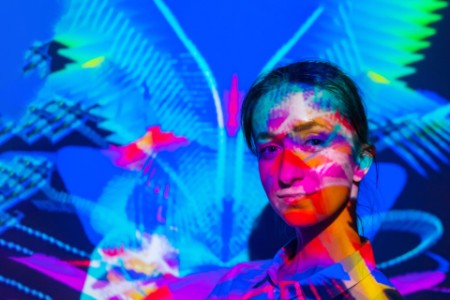
The better the question
How can you create real-life impact in the metaverse?
A leading global pharmaceutical company asked EY teams to help explore the business potential of the metaverse.
A leader in innovation and cutting-edge science, Takeda is in the top 15 pharma companies globally by revenue. The company has an ambition to become the world’s most trusted, science-driven pharmaceutical company and chose the EY organization to work closely with across the breadth of its digital transformation. The ultimate goal is to unleash the power of digital technologies and data to meet the evolving needs of its patients.
Takeda built an innovation hub to introduce digital solutions, artificial intelligence, robotics, automation and analytics to the business, and as the next step in this venture was interested in the metaverse. Takeda’s Chief Technology Officer, Leo Barella, first experienced the metaverse at EY wavespace™, which is a collaboration solution, and asked how to explore the business potential of the metaverse for Takeda and its industry.
The metaverse provides immersive experiences in a 3D digital world, where people can transact, socialize, play and work through digital representations of themselves, known as avatars.
The metaverse is in its early stages of maturity, reaching 400m monthly active users in 2022, according to consulting firm Metaversed. This is changing rapidly, with Bloomberg forecasting the market for metaverse to reach US$800 billion by 2024 and The Metaverse Insider estimating the market will reach US$5.8 trillion by 2030. With the power to transform industries, the metaverse is evolving as new 3D worlds are being created daily. It’s challenging to keep up, even for technologists.
Yet, how do you explore what you don’t know? Because the new era of digital health will include the integration of virtual reality, augmented reality and mixed reality, Ricci asked EY to help Takeda’s leadership team explore the art of the possible with metaverse.

The better the answer
From strategy to implementation in just four months
Agile collaboration with EY teams helped Takeda successfully design and implement its metaverse.
EY teams ran interactive, immersive experiences for the Takeda leadership team through EY wavespace™ to introduce them to leading practices in the metaverse, and to explore what the metaverse could mean for the organization, its employees and patients. With leading-edge collaboration tools, dedicated experience leaders who acted as innovation coaches and a proven approach infused with design thinking methods, EY wavespace helped Takeda bring to life how the metaverse could help enable the future of healthcare.
Co-creation and agility were the defining characteristics of this four-month project. During interactive workshops, the team was able to define a clear vision and scope for a proof of concept metaverse environment to support an immersive employee experience. Through the implementation of agile sprints, the teams identified and prioritized use cases, established the enterprise architecture and carried out rapid prototyping.
A single vision
The Takeda team worked with EY wavespace to identify and evaluate business challenges the metaverse could help solve. Collaboration across Takeda was key to the success of this project. This required the cooperation of multiple functions across Takeda, including Leadership, IT, HR and Talent Acquisition, Learning and Development, Research and Development, and Manufacturing.
The engagement also drew on a wide range of technology and business expertise across the EY organization, including innovation, emerging technologies, data and analytics, people and change, supply chain, and transformation.
Takeda leadership found that the atmosphere that EY wavespace created was ideal for innovation.
“EY wavespace was instrumental to this project. It gave us a positive space to convene the wide-ranging perspectives needed to explore the potential of the metaverse, together,” says Barella.
“The exercises we worked through sparked and accelerated the creative leap we needed to advance our thinking about how Takeda, our patients and the wider community could benefit from the metaverse.”
As a result, Takeda was able to consolidate and align around a single vision for the metaverse in a very short period of time: Creating a human-centered digital experience with immersive learning and collaboration to build deeper connections.
The exercises we worked through sparked and accelerated the creative leap we needed to advance our thinking about how Takeda, our patients and the wider community could benefit from the metaverse.
Choosing where to start
After identifying and analyzing many use cases for the metaverse, the Takeda-EY team aligned its strategy with business objectives and needs to focus on the following three:
- Immersive employee experience: attracting NextGen talent, improving onboarding, learning and collaborating
- Modernizing the product lifecycle: product launch, Research and Development, manufacturing and distribution
- Engaging patients and stakeholders: differentiating patient experience, patient communities, patient and provider connections and investor community engagement
The Takeda-EY team decided to start their launch into the metaverse by first focusing on an immersive employee experience, which presented the fastest way for Takeda’s people to benefit from the full impact of the metaverse, while also minimizing project risk. This approach helped to ensure that the team could drive adoption effectively and efficiently.
The proof of concept was designed to give employees:
- Meeting space to support immersive collaboration
- Onboarding and training space for employees to engage, learn and connect virtually
- Social space for employees to focus on team building and social connection
Building and launching the Takeda Metaverse
Creating an immersive, three-dimensional experience is different from building a website, mobile app or general applications. The EY Metaverse Lab came to the forefront with a multidisciplinary team that included 3D artists, cross-platform game engine developers, 3D modelers and animators, interior designers, user experience designers, full stack developers and solution architects, to help Takeda build a metaverse environment.
In terms of the design, it was important to Takeda leadership that the metaverse environment reflected the company’s brand, culture and values, as well as its commitment to patients, people and the planet. To reinforce this, the EY team digitally recreated the award-winning design of Takeda’s global headquarters in Tokyo, Japan, designed by Kashiwa Sato, and the Boston Takeda office, as well as adding new elements like a cultural center.
“This was a great example of bringing real life into digital seamlessly,” says Matt Mara, Extended Reality Platform Lead at Takeda. “The design of the metaverse captured the look and feel of Takeda’s identity and buildings, creating continuity for existing employees and a useful introduction for new employees. Feedback from leadership was overwhelmingly positive.”
The design of the metaverse captured the look and feel of Takeda’s identity and buildings, creating continuity for existing employees and a useful introduction for new employees.
The EY metaverse lab created two versions of Takeda’s metaverse environment to enable Takeda to de-risk their future platform investments and explore accessibility across platforms. One was on AltSpaceVR, a Microsoft platform leveraged by Takeda that enables continued integration into their ecosystem. The other was a leading metaverse platform, deployed in just one week, that employees could access via the internet. Both environments will allow Takeda to explore more metaverse use cases as they grow their business strategy.
“We really appreciated the emphasis on accessibility and the employee experience. Instead of technology setting limitations, they made sure it worked for us,” says Barella.
Rapid deployment was critical for Takeda. Together, Takeda and EY teams were able to define the vision and launch the metaverse for employee onboarding and learning in just four months. This innovative environment will be used to onboard new employees, attracting a younger, digital native generation of talent, as well as improving overall engagement and learning for existing employees.
Based on the various use cases identified with Takeda, the EY team also helped develop an enterprise reference architecture. This will serve as a framework for Takeda’s technical teams as they continue to integrate the Takeda metaverse into their infrastructure and evolve the environment into other areas of the business.
We really appreciated the emphasis on accessibility and the employee experience. Instead of technology setting limitations, they made sure it worked for us.

The better the world works
Great opportunity for future experimentation and growth
This is just the beginning. With a robust pipeline of use cases, Takeda also hopes to use the metaverse to further its net zero ambitions.
Experiencing the metaverse in action has deepened appreciation of the technology's benefits across Takeda and helped to drive adoption. Employees from around the globe will soon be able to connect in a 3D space, engage in immersive learning experiences and benefit from greater retention of content.
“Through the metaverse, we can create a truly global and inclusive workspace, transcending physical boundaries to foster collaboration and tap into the incredible talents of people around the world,” says Edwina Fitzmaurice, EY Global Chief Customer Success Officer.
Takeda expects to see improved employee engagement scores because the metaverse provides an immersive, collaborative, customizable and continuous learning experience that is more engaging and memorable than traditional training methods.
Recent statistics confirm a host of benefits from immersive learning, such as:
- 95% improvement in knowledge retention
- 70% improvement in employee performance compared to traditional training
- 60% faster workplace readiness during onboarding
Knowledge retention:
95%improvement in knowledge retention
Employee performance:
70%improvement in employee performance compared to traditional training
Workplace readiness:
60%faster workplace readiness during onboarding
These significant gains are due to the memorable nature of immersive experiences, says Ayoub Abielmona, EY engagement lead on the Takeda Metaverse. “It’s like the difference between looking at a holiday photo and being there. The metaverse invokes more of our senses – hearing, seeing, feeling – and that has a greater impact on our memory and recall.”
Through the metaverse, we can create a truly global and inclusive workspace that transcends physical boundaries to foster collaboration and tap into the incredible talents of people around the world.
The collaborative approach and emphasis on cross-discipline teaming both internally and with Takeda built a common understanding of what the metaverse means for Takeda and how best to leverage it as a platform for further experimentation and growth. With a robust pipeline of use cases, the company is exploring future metaverse opportunities, such as accelerating and modernizing commercial product launches and delivery, as well as enhancing patients’ lives.
EY and Takeda continue to work together on the metaverse, as well as the company’s wider digital transformation across technology, finance, tax and commercial, to explore new ways of innovating and engaging with patients, employees and the wider community.
The team
Contact us
Interested in the changes we have made here,
contact us to find out more.




